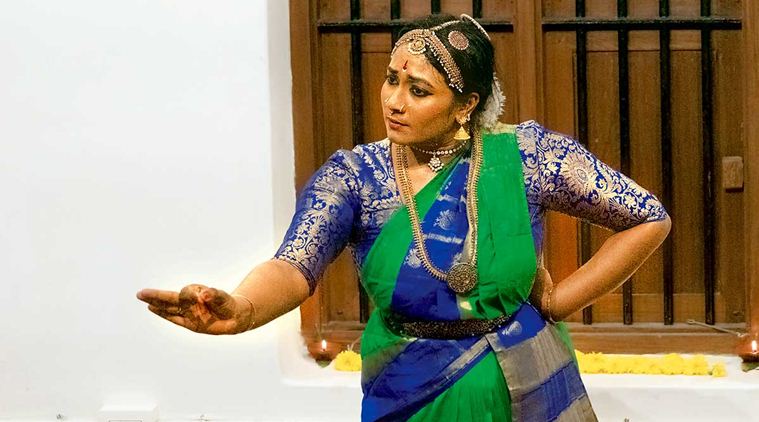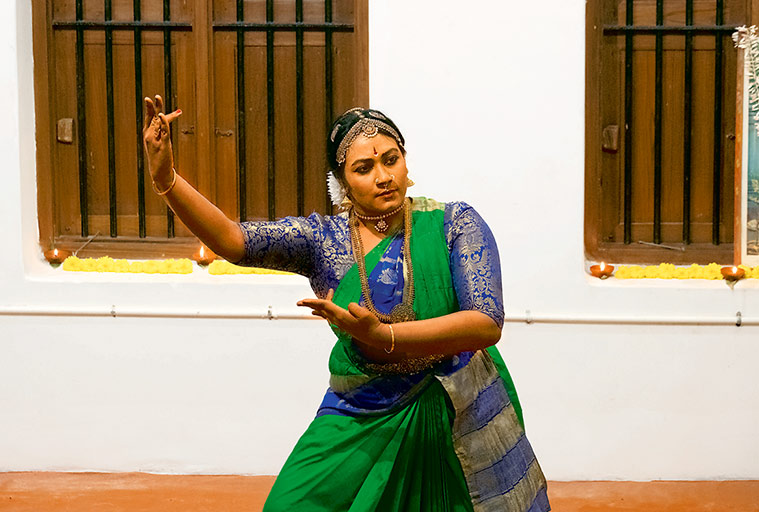 Step by step: Nrithya Pillai at a performance in Chennai. (Source: Arun Janardhanan)
Step by step: Nrithya Pillai at a performance in Chennai. (Source: Arun Janardhanan)
Last month, in the middle of Chennai’s famed Margazhi season, connoisseurs at the Brahma Gana Sabha were taken by surprise when they realised that the young Bharatanatyam dancer on stage was not winding up her performance with the traditional mangalam (an offering of thanks to god). Instead, Nrithya Pillai, 32, chanted “Jai Bhim”, and followed it up by reading out the Preamble to the Constitution.
Those who have followed Pillai’s trajectory in the last few years were not surprised, having seen the dancer ask tough questions of the Bharatanatyam tradition, to which she is linked by lineage. Pillai belongs to the Isaivellalar, a hereditary musical community living in Tamil Nadu for centuries. The Isaivellalar women, known as the devadasis, occupied a place of power and prestige, through the practice of classical music and dance in temples. The devadasi system was abolished in the 1920s, after a campaign against its “immorality” and the suspicion that the women were “prostitutes”.
Pillai is among a handful of people from the community who continue to practise Bharatanatyam today. Even till the 1930s, the Chennai Music Academy would host dancers from the devadasi community, like Kumbakonam Varalakshmi, Bhanumathi, and the legendary Balasaraswati. “Why is it that we do not get a space in the sabhas anymore?” asks Pillai. “I had only two programmes during this Margazhi season.”
Pillai’s performances, and her talks on the history of her community, is her way of reclaiming the tradition. She points out that the 1927 legislation to abolish the devadasi system was brought in by Muthulakshmi Reddy, a medical practitioner and member of the Madras Legislative Council, whose mother was a devadasi. “Many devadasis wrote letters and articles against it, they termed the abolition a human-rights violation as the devadasi system was also a right to livelihood based on art. But the entire community was targeted by the government. We were treated like a morally fallen sect, and this label eventually cancelled our right to dance and access to sabhas. Then, the art was opened up for others, upper-caste Hindus,” Pillai says. To arguments of oppression in the system, she counters: “But tell me which system doesn’t have it? Is the Music Academy in Chennai devoid of oppression and sexual abuses?” she says.
Last year, at a Natya Kala Conference, Pillai’s talk on caste, gender and privilege in Bharatanatyam earned her the wrath of a prominent critic, whose write-up was soon shared by many upper-caste dancers on social media, including those who learnt dance from her grandfather, the late Swamimalai Rajarathnam Pillai. It called her an “angry, venomous and bitter person,” and led to her being barred by prominent sabhas.
 Pillai’s performances, and her talks on the history of her community, is her way of reclaiming the tradition.
Pillai’s performances, and her talks on the history of her community, is her way of reclaiming the tradition.
But Pillai’s decision to speak up has given strength to other dancers from her community. “It was almost a shame (to belong to the devadasi community) earlier,” says one of the Bharatanatyam dancers in Chennai, requesting anonymity, because they feared a backlash from “a largely Brahmin-dominated circle of dancers”. Another dancer from Coimbatore, who follows Pillai’s performances and talks, says, “They labelled it as prostitution but Nrithya taught us it was their problem, that we were not wrong,” she says.
Pillai argues that the abolition was sociocultural violence against the Isaivellalar. While the women were denied entry by law, “you used the men from the same community to learn this art form, turning them into Bharatanatyam teachers.” She remembers her own grandfather as a gentle artiste, who never got the respect due to him. “Even if he had dreams for me, women in the family assumed that I cannot become a dancer or artist. He was a kind teacher. But the situation of Isaivellalar men also did not allow them to be assertive or demand respect,” she says.
In her talks, Pillai speaks with pride about women in her community, pioneers of the dance form, their history and her family lineage, and dedicates each piece to a dancer from her community. “Even if the society may not encourage me to take pride in my devadasi lineage, I still had an instinct to do this,” she says.
The reformers, led by Reddy, did not understand that the Isaivellalar were a matrilineal caste, where women enjoyed many rights. “It was a powerful system and ensured the social security of women…devadasi women had access to land, money and social structures,” Pillai says. A new, more conservative morality of the early 20th century failed to acknowledge that.
One of the padams she performed at Brahma Gana Sabha last month was Yaarukkakilum Bhayamaa, which asks, “Why should I be scared of anyone?” Do these radical steps, the chanting of “Jai Bhim” make her a Periyarist or Ambedkarite in Chennai? “No,” she says. The 1927 legislation that said that “any women dancing in a social gathering in the temple premises, or any place, is a crime,” was supported not only by Reddy but also a social reformer like Periyar, she points out. “Even Periyarists and Ambedkarites consider Bharatanatyam as an art form of the upper castes now. After I said Jai Bhim, they started engaging with me,” Pillai says.
The Isaivellalar was disempowered both by the left and the right, says Pillai, because “morality for everyone is Brahminical” and female sexuality was suspect for all. Pillai sees the purge of the devadasis from classical music and dance as a “process of appropriation”. “Our saviours and enemies are the same. Those fighting for the ‘lower caste’ and marginalised are also upper caste… This has been so for time immemorial,” she says.
“The devadasi system is long gone but we are its remnants. But someone like me reclaiming my heritage is like saying we are the daughters of the witches you burnt.”